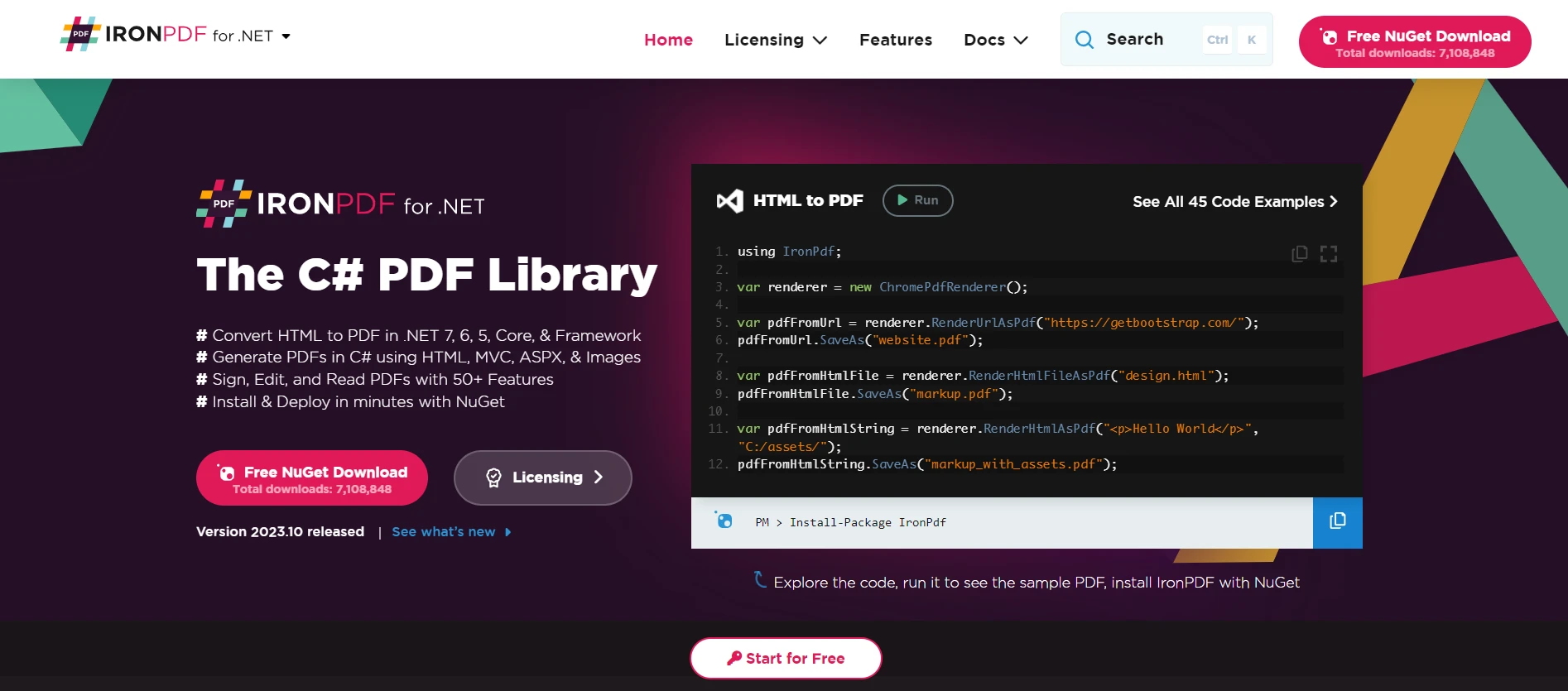Test in production without watermarks.
Works wherever you need it to.
Get 30 days of fully functional product.
Have it up and running in minutes.
Full access to our support engineering team during your product trial
C# is one of the popular programming languages for building dynamic and scalable applications. One of the strengths of this language lies in its vast library of built-in functions, particularly math functions. In this tutorial, we will delve deep into the various math functions C# provides, helping you become familiar with the Math class and how to perform common mathematical equations with ease.
In C#, the Math class is a static class available within the System namespace. This class contains a plethora of methods designed to help developers perform mathematical operations without the need to write them from scratch.
To access the Math class, you need to include the System namespace in your public class Program. Here's how:
using System;
public class Program
{
//public static void Main method
public static void Main()
{
// Your code goes here
}
}using System;
public class Program
{
//public static void Main method
public static void Main()
{
// Your code goes here
}
}Imports System
Public Class Program
'public static void Main method
Public Shared Sub Main()
' Your code goes here
End Sub
End ClassIn the public static void main method, you can call any function from the Math class by referencing Math.
Let's look at some basic math functions that C# provides
Absolute Value: The absolute value of a specified number is its value without its sign. The function Math.Abs() takes in a number and returns the absolute value.
double val = -10.5;
double absValue = Math.Abs(val); //function returns absolute value
Console.WriteLine(absValue); // Output: 10.5double val = -10.5;
double absValue = Math.Abs(val); //function returns absolute value
Console.WriteLine(absValue); // Output: 10.5Dim val As Double = -10.5
Dim absValue As Double = Math.Abs(val) 'function returns absolute value
Console.WriteLine(absValue) ' Output: 10.5Square Root: To find the square root of a specified number, you use the Math.Sqrt() function. This function calculates the square root and returns a double value as shown in the following example.
double value = 16;
double sqrtValue = Math.Sqrt(value);
Console.WriteLine(sqrtValue); // Output: 4double value = 16;
double sqrtValue = Math.Sqrt(value);
Console.WriteLine(sqrtValue); // Output: 4Dim value As Double = 16
Dim sqrtValue As Double = Math.Sqrt(value)
Console.WriteLine(sqrtValue) ' Output: 4Rounding Numbers: C# offers several functions to round numbers to the nearest integer or a specified number of decimal places. The Math.Round() function rounds a floating-point value to the nearest integer or integral part.
double value = 10.75;
double roundedValue = Math.Round(value); // rounds to the nearest whole number
Console.WriteLine(roundedValue); // Output: 11double value = 10.75;
double roundedValue = Math.Round(value); // rounds to the nearest whole number
Console.WriteLine(roundedValue); // Output: 11Dim value As Double = 10.75
Dim roundedValue As Double = Math.Round(value) ' rounds to the nearest whole number
Console.WriteLine(roundedValue) ' Output: 11Besides basic arithmetic operations, the Math class in C# also provides a range of trigonometric and hyperbolic functions
Sine Value: To find the sine value of a specified angle (in radians), use Math.Sin().
double angle = Math.PI / 2; // 90 degrees
double sineValue = Math.Sin(angle);
Console.WriteLine(sineValue); // Output: 1double angle = Math.PI / 2; // 90 degrees
double sineValue = Math.Sin(angle);
Console.WriteLine(sineValue); // Output: 1Dim angle As Double = Math.PI / 2 ' 90 degrees
Dim sineValue As Double = Math.Sin(angle)
Console.WriteLine(sineValue) ' Output: 1Hyperbolic Functions: These are similar to trigonometric functions but are used for hyperbolic equations. Some examples include Math.Sinh() (hyperbolic sine), Math.Cosh() (hyperbolic cosine), and Math.Tanh() (hyperbolic tangent).
double value = 1;
double hyperbolicSine = Math.Sinh(value);
double hyperbolicCosine = Math.Cosh(value);
double hyperbolicTangent = Math.Tanh(value);double value = 1;
double hyperbolicSine = Math.Sinh(value);
double hyperbolicCosine = Math.Cosh(value);
double hyperbolicTangent = Math.Tanh(value);Dim value As Double = 1
Dim hyperbolicSine As Double = Math.Sinh(value)
Dim hyperbolicCosine As Double = Math.Cosh(value)
Dim hyperbolicTangent As Double = Math.Tanh(value)For those looking for more advanced operations:
Power: The Math.Pow() function takes in two integers: a base and an exponent. It returns the base number raised to the specified power.
double baseNum = 2;
double exponent = 3;
double result = Math.Pow(baseNum, exponent);
Console.WriteLine(result); // Output: 8double baseNum = 2;
double exponent = 3;
double result = Math.Pow(baseNum, exponent);
Console.WriteLine(result); // Output: 8Dim baseNum As Double = 2
Dim exponent As Double = 3
Dim result As Double = Math.Pow(baseNum, exponent)
Console.WriteLine(result) ' Output: 8Logarithm: C# offers the Math.Log() function, which calculates the natural logarithm (base e) of a specified number. Additionally, you can specify a base using Math.Log(number, specified base).
double value = 10;
double naturalLog = Math.Log(value); // Natural logarithmic base
double logBase10 = Math.Log(value, 10); // Base 10 logarithmdouble value = 10;
double naturalLog = Math.Log(value); // Natural logarithmic base
double logBase10 = Math.Log(value, 10); // Base 10 logarithmDim value As Double = 10
Dim naturalLog As Double = Math.Log(value) ' Natural logarithmic base
Dim logBase10 As Double = Math.Log(value, 10) ' Base 10 logarithmThough this tutorial primarily deals with basic and intermediate functions, it's worth noting that C# provides support for complex numbers
Creating a Complex Number: Use the Complex class from the System.Numerics namespace. It's not part of the Math class, but it's essential for mathematical operations involving complex numbers.
using System.Numerics;
Complex complexNumber = new Complex(2, 3); // Represents 2 + 3iusing System.Numerics;
Complex complexNumber = new Complex(2, 3); // Represents 2 + 3iImports System.Numerics
Private complexNumber As New Complex(2, 3) ' Represents 2 + 3iOften, developers need to convert between different types of numeric values:
Convert to Integer: If you have a double and wish to convert it to an integer by removing its decimal value, use the Convert.ToInt32() method.
double value = 10.99;
int intValue = Convert.ToInt32(value);
Console.WriteLine(intValue); // Output: 10double value = 10.99;
int intValue = Convert.ToInt32(value);
Console.WriteLine(intValue); // Output: 10Dim value As Double = 10.99
Dim intValue As Integer = Convert.ToInt32(value)
Console.WriteLine(intValue) ' Output: 10Decimal to Binary: C# doesn't have a direct method in the Math class for this. However, you can use the Convert.ToString(value, 2) function from the System namespace.
When working with Math functions, you might sometimes encounter errors, like dividing by zero. It's essential to handle these potential pitfalls:
Divide by Zero: Use a conditional statement to check the divisor before performing a division.
double numerator = 10;
double denominator = 0;
if(denominator != 0)
{
double result = numerator / denominator;
}
else
{
Console.WriteLine("Cannot divide by zero!");
}double numerator = 10;
double denominator = 0;
if(denominator != 0)
{
double result = numerator / denominator;
}
else
{
Console.WriteLine("Cannot divide by zero!");
}Dim numerator As Double = 10
Dim denominator As Double = 0
If denominator <> 0 Then
Dim result As Double = numerator / denominator
Else
Console.WriteLine("Cannot divide by zero!")
End IfHandle Overflow: When a mathematical operation results in a value too large for its data type, an overflow occurs. Use checked blocks to catch this exception.
try
{
checked
{
int result = int.MaxValue + 1; // This will cause an overflow
}
}
catch(OverflowException ex)
{
Console.WriteLine("Overflow occurred: " + ex.Message);
}try
{
checked
{
int result = int.MaxValue + 1; // This will cause an overflow
}
}
catch(OverflowException ex)
{
Console.WriteLine("Overflow occurred: " + ex.Message);
}Try
'INSTANT VB TODO TASK: There is no equivalent to a 'checked' block in VB:
' checked
Dim result As Integer = Integer.MaxValue + 1 ' This will cause an overflow
'INSTANT VB TODO TASK: End of the original C# 'checked' block.
Catch ex As OverflowException
Console.WriteLine("Overflow occurred: " & ex.Message)
End TryAs we delve into the capabilities of C#, it's worth noting that the ecosystem around this programming language has evolved tremendously. One such contribution comes in the form of Iron Suite, a comprehensive toolkit tailored for C# developers. It offers a set of products that can supercharge your applications, ensuring that they are robust and feature-rich.

Ever felt the need to work with PDFs in your C# applications? IronPDF for PDF Integration in C# Applications is your go-to solution. It makes it incredibly simple to create, edit, and even extract content from PDF files. When you combine it with the math functions of C#, you can generate reports, graphs, and other mathematical visualizations and embed them seamlessly into your PDF documents.
A standout feature of IronPDF is its HTML to PDF Conversion Feature capability, keeping all layouts and styles intact. It generates PDFs from web content, suitable for reports, invoices, and documentation. HTML files, URLs, and HTML strings can be converted to PDFs effortlessly.
using IronPdf;
class Program
{
static void Main(string[] args)
{
var renderer = new ChromePdfRenderer();
// 1. Convert HTML String to PDF
var htmlContent = "<h1>Hello, IronPDF!</h1><p>This is a PDF from an HTML string.</p>";
var pdfFromHtmlString = renderer.RenderHtmlAsPdf(htmlContent);
pdfFromHtmlString.SaveAs("HTMLStringToPDF.pdf");
// 2. Convert HTML File to PDF
var htmlFilePath = "path_to_your_html_file.html"; // Specify the path to your HTML file
var pdfFromHtmlFile = renderer.RenderHtmlFileAsPdf(htmlFilePath);
pdfFromHtmlFile.SaveAs("HTMLFileToPDF.pdf");
// 3. Convert URL to PDF
var url = "http://ironpdf.com"; // Specify the URL
var pdfFromUrl = renderer.RenderUrlAsPdf(url);
pdfFromUrl.SaveAs("URLToPDF.pdf");
}
}using IronPdf;
class Program
{
static void Main(string[] args)
{
var renderer = new ChromePdfRenderer();
// 1. Convert HTML String to PDF
var htmlContent = "<h1>Hello, IronPDF!</h1><p>This is a PDF from an HTML string.</p>";
var pdfFromHtmlString = renderer.RenderHtmlAsPdf(htmlContent);
pdfFromHtmlString.SaveAs("HTMLStringToPDF.pdf");
// 2. Convert HTML File to PDF
var htmlFilePath = "path_to_your_html_file.html"; // Specify the path to your HTML file
var pdfFromHtmlFile = renderer.RenderHtmlFileAsPdf(htmlFilePath);
pdfFromHtmlFile.SaveAs("HTMLFileToPDF.pdf");
// 3. Convert URL to PDF
var url = "http://ironpdf.com"; // Specify the URL
var pdfFromUrl = renderer.RenderUrlAsPdf(url);
pdfFromUrl.SaveAs("URLToPDF.pdf");
}
}Imports IronPdf
Friend Class Program
Shared Sub Main(ByVal args() As String)
Dim renderer = New ChromePdfRenderer()
' 1. Convert HTML String to PDF
Dim htmlContent = "<h1>Hello, IronPDF!</h1><p>This is a PDF from an HTML string.</p>"
Dim pdfFromHtmlString = renderer.RenderHtmlAsPdf(htmlContent)
pdfFromHtmlString.SaveAs("HTMLStringToPDF.pdf")
' 2. Convert HTML File to PDF
Dim htmlFilePath = "path_to_your_html_file.html" ' Specify the path to your HTML file
Dim pdfFromHtmlFile = renderer.RenderHtmlFileAsPdf(htmlFilePath)
pdfFromHtmlFile.SaveAs("HTMLFileToPDF.pdf")
' 3. Convert URL to PDF
Dim url = "http://ironpdf.com" ' Specify the URL
Dim pdfFromUrl = renderer.RenderUrlAsPdf(url)
pdfFromUrl.SaveAs("URLToPDF.pdf")
End Sub
End Class
Data manipulation is a significant aspect of programming, and when it comes to spreadsheets, IronXL for Excel Interop in C# has you covered. Whether you're creating, reading, or editing Excel files, IronXL integrates effortlessly with C#. With the power of C# math functions, you can perform computations on your Excel data directly within your applications.

Optical Character Recognition (OCR) is no longer a futuristic concept but a reality with IronOCR for Extracting Text from Images and PDFs. If you have an application that deals with images or scanned documents and you wish to extract text, especially numerical data or math equations, IronOCR combined with C# can seamlessly recognize and translate that into usable data.

In today's world, barcodes play an integral role in product identification. With IronBarcode for Generating and Reading Barcodes in C#, C# developers can easily generate, read, and work with barcodes. It can be especially useful if you're developing inventory or point-of-sale systems where mathematical calculations and barcodes intertwine.

The C# landscape is vast and powerful, and with tools like Iron Suite, you can elevate your applications to new heights. Notably, each product within the Iron Suite, be it IronPDF, IronXL, IronOCR, or IronBarcode, begins with a license starting from $749. Moreover, for those looking to try before investing, each product offers a 30-day free trial for Iron Suite's Extensive Features for the price of just two products. Such a deal not only offers cost savings but also ensures you have a comprehensive toolkit to meet your diverse development needs.